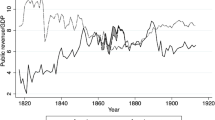Abstract
We use the Michigan Model of World Production and Trade to assess the sectoral effects of (1) a 25 percent unilateral reduction of military expenditures in the individual NATO countries and (2) a 25 percent multilateral reduction of military expenditures in all of the NATO countries combined. Our principal findings suggest that the overall effects of the unilateral and multilateral reductions are not substantial and that the results of the two reductions are qualitatively similar. The sectoral results, which are also broadly similar in the two experiments, suggest that sectors such as basic metals and metal products, durable goods, and community, social, and personal services might be in need of transitional adjustment assistance for displaced workers in the event that the reductions in military expenditures would in fact be carried out.
Similar content being viewed by others
References
Barker, Terry, Paul Dunne, and Ron Smith (1990) “The Peace Dividend and the U.K. Economy,” unpublished manuscript, University of Cambridge, United Kingdom.
Deardorff, Alan V. and Robert M. Stern (1986)The Michigan Model of World Production and Trade: Theory and Applications. Cambridge: MIT Press.
Deardorff, Alan V. and Robert M. Stern (1990)Computational Analysis of Global Trading Arrangements. Ann Arbor: University of Michigan Press.
Dunne, J. Paul (1991) “Conversion and Employment: A Comparative Assessment,” DAE Working Paper No. 9116 (August), Department of Applied Economics, University of Cambridge.
Filip-Kohn, R., R. Krengel, and D. Schumacher (1980) “Macro-Economic Effects of Disarmament Policies on Sectoral Production and Employment in the Federal Republic of Germany, with Special Emphasis on Development Policy Issues,” German Institute for Economic Research, Berlin.
Fox, Alan K. and Robert M. Stern (1993) “Effects of Reductions in NATO Military Expenditures on U.S. Employment by Sector/Occupation/Region,”The World Economy, Forthcoming.
Haveman, Jon D., Alan V. Deardorff, and Robert M. Stern (1992) “Some Economic Effects of Unilateral and Multilateral Reductions in Military Expenditures in the Major Industrialized and Developing Countries,”Journal of Conflict Management and Peace Science 12, 47–78.
Herring, P.G. (1989) “The Economic Impact of Defence Expenditures: FY 1987/88,” Centre for Studies in Defence Resources Management, Report #18, National Defence College of Canada, Kingston, Canada.
Leontief, Wassily W. and Faye Duchin (1983)Military Spending: Facts and Figures, Worldwide Implications and Future Outlook. New York: Oxford University Press.
Steuerle, Eugene C. and Susan Wiener (1990) “Spending the Peace Dividend: Lessons From History,” Urban Institute Policy Paper, Washington, D.C.
United States Arms Control and Disarmament Agency (1990)World Military Expenditures and Arms Transfers 1989. Washington: U.S. Government Printing Office.
United States Department of Commerce, (1990)The Survey of Current Business (January), Washington: Bureau of Economic Analysis.
Author information
Authors and Affiliations
Rights and permissions
About this article
Cite this article
Haveman, J.D., Deardorff, A.V. & Stern, R.M. Sectoral effects of reductions in NATO military expenditures in the major industrialized and developing countries. Open Econ Rev 4, 247–268 (1993). https://doi.org/10.1007/BF01000044
Issue Date:
DOI: https://doi.org/10.1007/BF01000044




